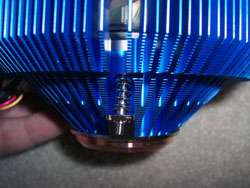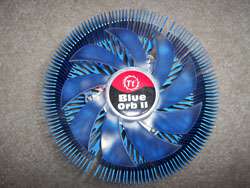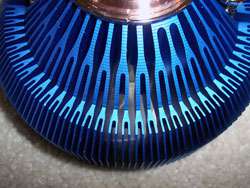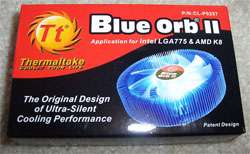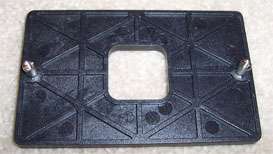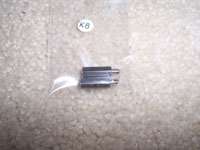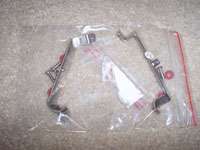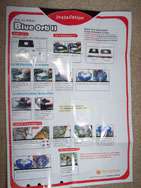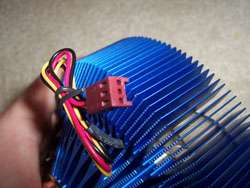- Qualcomm Launches Snapdragon 4 Gen 2 Mobile Platform
- AMD Launches Ryzen PRO 7000 Series Mobile & Desktop Platform
- Intel Launches Sleek Single-Slot Arc Pro A60 Workstation Graphics Card
- NVIDIA Announces Latest Ada Lovelace Additions: GeForce RTX 4060 Ti & RTX 4060
- Maxon Redshift With AMD Radeon GPU Rendering Support Now Available
Thermaltake Blue Orb II
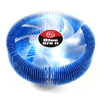
Page 2 – The Product
It is said that copper conducts heat better than aluminum yet aluminum can radiate the heat away faster. This is interesting because the Blue Orb I have here, combines both copper and aluminum in its design. The base of this cooler is made of a copper slug. The base is approx. the size of a half dollar (US) and is connected to the aluminum fins.
There are a lot of similarities with this cooler to the Zalman 7700. The basic design is the same as both sport a 120mm fan sunk into the cooling fins of the cooler. That, it seems, is where the similarities end. The Blue Orb II is sporting Thermaltake’s new crotched fin design. What this is basically is a tree pattern. Where the aluminum fins meet the copper base, the aluminum is somewhat thick and as it reaches out, away from the base, it branches out into thinner fins. Repeat this pattern twice and you have the Blue Orb II. I am not going to pretend to have counted the fins but let me tell you, there are a lot. How about we take a look at the crotched fins?
Now that’s some crotch action!
Also included in the package is a small box. Like stated earlier, this box contains all the necessary adapters, stand offs and various other hardware that you will need to install this cooler on your CPU.
Installation didn’t take near as long as it took to remove the motherboard tray. Once removed, I replaced the back plate brace with the one provided in the box, attached the standoffs and went to town on the cooler. There was a fair amount of force needed to get the cooler screwed into the standoffs but no more than any other cooler I have worked with. Instead of screwing your screws until tight enough, all you have to do with this cooler is get the screws into the standoffs enough that they wont come out and the springs on the screws themselves will provide the needed tension and hold your cooler in place.
The fan used the 3-pin connector that virtually all coolers use. Not much to report on that.
|
|
Support our efforts! With ad revenue at an all-time low for written websites, we're relying more than ever on reader support to help us continue putting so much effort into this type of content. You can support us by becoming a Patron, or by using our Amazon shopping affiliate links listed through our articles. Thanks for your support!




